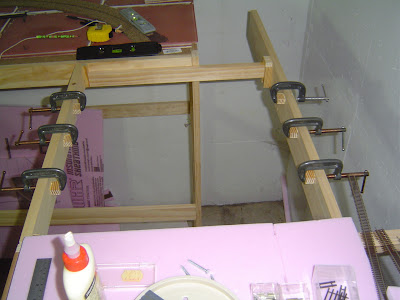The resale on this chunk of benchwork is effectively nil, due in large part to the fact that I change my mind about the layout more often than I change my underwear, the result of which is that it's as irregular as a three-dollar bill.
Just for example, the leg of the benchwork that I refer to as the "three-foot extension" is in fact thirty-seven and three-quarters inches wide. Try to find a piece of stock hardboard to fit
that. The layout's been through so many permutations that I have no idea anymore how it ended up this wide.

Here's another excellent example: It may not be obvious from this photo, but when you eyeball it face-to-face, as it were, you can plainly see that the stringers supporting the foam board on the left are obviously higher than the stringers on the right. They are, in fact, almost three-quarters of an inch higher.
I know how I did that, but I'm too embarrassed to explain it right now.

Today's project: Begin to fix these screw-ups. There's no way I can adjust the width of the three-foot extension now, but I can pull out and lower the stringers, which I'll have to do to execute my next fix: Replacing the foam board top.

An article in Model Railroader led me to believe I could lay track directly on the foam board, which could be laid directly on the bench work. Which is factually true: I really could very easily do that, but when I ran a couple locomotives across the track to see them go, every one of them made enough noise to stampede a herd of longhorns. It damn near stampeded me.
So I'm going to put an old-fashioned layer of hardboard across the stringers and an old-fashioned layer of ceiling tiles over that, then lay track on a cork road bed, just as I should have done from the beginning.
 The kludge goes on as I bridge the gap between the two-foot extension (in the background) and the original bench work (in the extreme foreground).
The kludge goes on as I bridge the gap between the two-foot extension (in the background) and the original bench work (in the extreme foreground). 




































